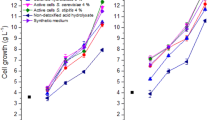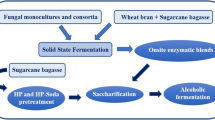Abstract
Bagasse, corn cob, and rice straw agricultural wastes were found to consist of 37, 39 and 34% cellulose and 24, 41 and 22% hemicellulose, respectively, on a dry solid (w/w) basis and thus have the potential to serve as a low cost foodstock for ethanol production. Hydrolysates produced by dilute-acid pretreatment followed by cellulase digestion were evaluated as substrates for ethanol fermentation bySaccharomyces cerevisiae. After pretreatment by 141 mM sulphuric acid, bagasse waste released glucose (134 mg/g) at a higher level than that from corn cob (75 mg/g) and rice straw (8 mg/g). Hydroxymethylfurfural (HMF) levels derived from acid pretreatment of bagasse (1.5 g/l), but not corn cob (0.8 g/l) or rice straw (0.1 g/l) attained levels likely to be toxic (1.5 g/l) forS. cerevisiae growth and ethanol fermentation rates. All three agricultural wastes released likely non-toxic levels of furfural (<0.5 g/l) and lactic acid (negligible for bagasse and rice straw and 0.7 g/l for corn cob). After cellulase saccharification of the dilute-acid pretreated agricultural wastes, the glucose content of corn cob hydrolysates (13 ± 0.17 g/l) was marginally higher than that of bagasse (12 ±0.27 g/l) or rice straw (11 ± 0.07 g/l), yet the ethanol conversion yield byS. cerevisiae on corn cob hydrolysate (0.45 ± 0.006 g/g) was lower than that attained with bagasse hydrolysate (0.49 ± 0.007 g/g). Synergistic adverse effects between furfural and HMF with weak acids, or other lignin derived products in the corn cob hydrolysate are proposed as the effective inhibitor (s) for ethanol fermentation byS. cerevisiae.
Similar content being viewed by others
References
Alves L.A., Felipe M.C.A., Silva J.B., Prata A.M.R. (1998). Pretreatment of sugarcane bagasse hemicellulose hydrolyzate for xylitol production byCandida guilliermondii. Appl. Biochem. Biotechnol., 70–72: 89–98.
Banerjee N., Bhatnagnar R., Viswanathan L. (1981). Inhibition of glycolysis by furfural inSaccharomyces cerevisiae. Eur. J. Appl. Microbiol. Biotechnol., 11: 226–228.
Davis L., Jeon Y.-J., Svenson C., Rogers P., Pearce J., Peiris P. (2005). Evaluation of wheat stillage for ethanol production by recombinantZymomonas mobilis. Biomass Bioenerg., 29: 49–59.
Delgenes J.P., Moletta R., Navarro J.M. (1996). Effects of lignocellulose degradation products on ethanol fermentations of glucose and xylose bySaccharomyces cerevisiae, Zymomonas mobilis, Pichia stipitis, andCandida shehatae. Enzyme Microb. Technol., 19: 220–225.
Dien B.S., Nichols N.N., O’Bryan P.J., Bothast R.J. (2000). Development of new ethanologenicEscherichia coli strains for fermentation of lignocellulosic biomass. Appl. Biochem. Biotechnol., 84–86: 181–186.
Ghose T.K. (1987). Measurement of cellulase activities (Recommendations of Commission on Biotechnology IUPAC). Pure Appl. Chem., 59: 257–268.
Hinman N.D., Schell D.J., Riley C.J., Bergeron, P.W. Walter, D.J. (1992). Preliminary estimate of the cost of ethanol production for SSF technology. Appl. Biochem. Biotechnol., 34–35: 639–649.
Ho N.W.Y., Chen Z., Brainard A.P. (1998). Genetically engineeredSaccharomyces yeast capable of effective cofermentation of glucose and xylose. Appl. Env. Microbiol., 64 (5): 1852–1859.
Karimi K., Emtiazi G., Taherzadah M.J. (2006). Production of ethanol and mycelial biomass from rice straw hemicellulose hydrolyzate byMucor indicus. Process Biochem., 41: 653–658.
Kongruang S., Han M.J., Breton C.I., Penner, M.H. (2004). Quantitative analysis of cellulose-reducing ends. Appl. Biochem. Biotechnol., 113–116: 213–231.
McCarthy J.E., and Tiemann M. (1998). CRS report for congress. MTBE in gasoline: clean air and drinking water issues. Available from http://www.epa.gov/otaq /consumer/fuels/mtbe/crsmtbe.pdf.
McMillan J.D. (1994). Pretreatment of lignocellulosic biomass. In: Himmel M.E., Barker J.O., Overend R.P., Eds, Enzymatic Conversion of Biomass for Fuels Production. American Chemical Society, Washington, DC, pp. 292–324.
Miller G.L. (1959). Use of dinitrosalicylic reagent for the determination of reducing sugar. Anal. Chem., 31: 426–428.
Mussatto S.I., Roberto I.C. (2004). Alternatives for detoxification of diluted-acid lignocellulosic hydrolyzates for use in fermentative processes: a review. Bioresource Technol., 93: 1–10.
Nguyen Q.A., Tucker, M.P. Boynton, B.L. Keller, F.A. Schell, D.J. (1998). Dilute acid pretreatment of softwoods-scientific note. Appl. Biochem. Biotech., 7092: 77–87.
Nigam J.N., (2002). Bioconversion of water-hyacinth(Eichhornia crassipes) hemicellulose acid hydrolysate to motor fuel ethanol by xylose-fermenting yeast. J. Biotechnol., 97: 107–116.
Palmqvist E., Hanh-Hagerdal B. (2000). Fermentation of lignocellulosic hydrolysates. I: inhibition and detoxification. Bioresource Technol., 74: 17–24.
Pampulha M.E., Loureiro V. (1989). Interaction of the effects of. acetic acid and ethanol on inhibition of fermentation inSaccharomyces cerevisiae. Biotechnol. Lett., 2: 269–274.
Parajo J.C., Dominguez H., Dominguez J.M. (1998). Biotechnological producation of xylitol. Part 3: operation in culture media made from lignocellulose hydrolysates. Bioresource Technol., 66: 25–40.
Saha B.C., Iten L.B., Cotta M.A., Wu Y.V. (2005). Dilute acid pretreatment, enzymatic saccharification and fermentation of wheat straw to ethanol. Process Biochem., 40: 3693–3700.
Sternberg D., Vijaykumar P., Reese E.T. (1977). β-Glucosidase: microbial production and effect on enzymatic hydrolysis of cellulose. Can. J. Microbiol., 23: 139–147.
Sun Y., Cheng J. (2002). Hydrolysis of lignocellulosic materials for ethanol production: a review. Bioresource Technol., 83: 1–11.
Szczodrak J., Fiedurek J. (1995). Technology for the conversion of lignocellulosic biomass to ethanol. Biomass Bioenerg., 10 (5/6): 367–375.
TAPPI — Technical Association of Pulp and Paper Industry (1988). Test method for determination of alpha-beta and gamma-cellulose in pulp. TAPPI 203 om-88.
Wang M., Saricks C., Santini D. (1999). Effects of Fuel Ethanol Use on Fuel-Cycle Energy and Greenhouse Gas Emissions. Argonne National Laboratory, Argonne, IL.
Author information
Authors and Affiliations
Corresponding author
Rights and permissions
About this article
Cite this article
Sumphanwanich, J., Leepipatpiboon, N., Srinorakutara, T. et al. Evaluation of dilute-acid pretreated bagasse, corn cob and rice straw for ethanol fermentation bySaccharomyces cerevisiae . Ann. Microbiol. 58, 219–225 (2008). https://doi.org/10.1007/BF03175320
Received:
Accepted:
Issue Date:
DOI: https://doi.org/10.1007/BF03175320




